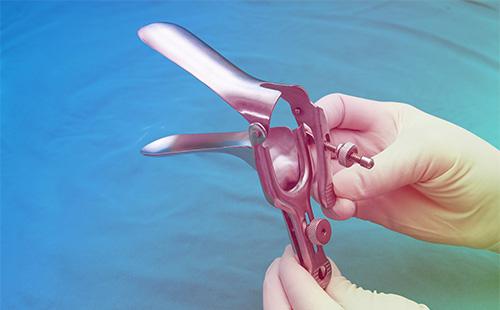The content of the article
A synonym for leukoplakia is “diskeratosis”, it is often established only after histological examination of the material. According to the classification of ICD-10, pathology is included in the heading "Other non-inflammatory diseases of the cervix uteri" under the code N88. Reliable reasons for the development of leukoplakia have not been established, therefore, it is often difficult to make a prognosis for the disease.
Let's not be confused with words like leukopenia, leukemia, leukoscopy and leukotomy.
The literal translation of the word "leukoplakia" from Greek means "white plaque." Indeed, pathological areas on the neck when viewed with the naked eye look like a white coating - photos can easily be found on the Internet. Regarding what are the symptoms of leukoplakia ... It is very unpleasant in this disease that it usually proceeds without symptoms, which means that in most cases it can be detected completely by accident, only during the examination at the next visit to the gynecologist.
What triggers the pathology
Cervical leukoplakia is not cancer, there is no accurate data or studies to support this. But pathology is included in the category of facultative precancers - diseases that are optional, but can nevertheless degenerate into malignant. Statistics indicate that concomitant leukoplakia is found in 30% of cases of cervical cancer. Despite the fact that reliable causes of cervical leukoplakia have not yet been established, a category of women who are most susceptible to similar changes in the cervix is distinguished.
- Improper hygiene. Failure to comply with basic hygiene measures or, conversely, their excessive implementation, leads to changes in the functions of the sex glands and integument epithelium. This is a risk factor for the development of leukoplakia. It is recommended to wash yourself once or twice a day, without using intimate oils and creams, wet wipes. Douching should not be the "norm", they should be performed only as directed by the doctor.
- Genital infections. A special role in the development of leukoplakia is given to viral lesions of the cervix and vagina. In particular, various HPV strains (human papillomavirus), as well as CMV (cytomegalovirus) andchlamydia. This is due to the fact that these pathogens are embedded in the genome of cells, changing their metabolism and reactions, after which they acquire new properties, in particular keratinization. Other sexually transmitted infections (STIs), if they translate into chronic forms, also play a significant role in the development of leukoplakia.
- Endocrine diseases. Pathologies such as diabetes mellitus, diseases of the thyroid gland, adrenal glands affect not only individual organs, but also the functioning of the body as a whole.The ratio of sex hormones, the ability of cells to update, is changing. The risk of mutations increases, and, as a result, epithelial cells begin to desquamate them uncharacteristically. In many situations, treatment will be ineffective without a proper diet.
- Chronic immunodeficiencies. Diseases that lead to a decrease in immunity (hereditary, acquired - HIV, blood pathology) stimulate an inadequate response of body cells to external influences and internal changes. Failures lead to various diseases, including leukoplakia.
- Cervical injuries. A large number of births with ruptures of the cervix, frequent curettage (including during abortions), cauterization, trauma by foreign objects leads to the fact that cells are forced to renew more often than usual. This increases the likelihood of mutations, malfunctions in the division.
How does it manifest
Signs of cervical leukoplakia are scarce in most cases, women rarely pay due attention to them. Therefore, often the disease for a long time goes unnoticed. The main ones include the following:
- an increase in whites that is not characteristic of a woman;
- white with an unpleasant odor;
- a slight discharge of blood after sex;
- persistent itching in the perineum and genitals;
- when external genitalia are involved in the process, white spots appear on them.
Pain does not accompany leukoplakia. Its appearance is associated with the appearance of complications or other diseases.

What happens
Depending on the clinical course, it is customary to distinguish the following options for leukoplakia.
- Simple or flat. One of the common forms. In this case, the foci of leukoplakia look like ordinary white spots on the cervix and vagina. They are often noticeable even without colposcopy. With a thorough examination, it is noticeable that, in addition to color, the tissues do not differ from adjacent ones - in terms of elasticity, relief, “plaque” is not easily removed when the instrument is touched (unlike, for example, candida), but only with effort, but with the appearance of bloody discharge in this place.
- Verrucous or verrucous. The resulting growths are similar to ordinary warts. They appear due to the fact that keratinizing epithelial cells actively proliferate, but do not desquamate, but grow “like a horn”. At the same time, they are easily removed with a tool, leaving a mark on the neck in the form of a pinkish spot. It is necessary to distinguish from ordinary papillomatous growths.
- Ulcerative necrotic. It is characterized by the fact that keratinizing cells are rejected over time with the formation of ulcers. It is necessary to differentiate with ordinary erosion, often the diagnosis can only be understood with the help of a biopsy and subsequent tissue examination.
How to identify and confirm an ailment
Leukoplakia, like many other diseases of the cervix, is asymptomatic. Therefore, they are discovered by chance - during preventive examinations, when registering for pregnancy. Sometimes leukoplakia becomes a "find" even for a doctor when performing an extended examination of a woman. The following methods help identify the ailment.
- General inspection in the mirrors. A gynecologist, even with the naked eye, can see white spots on the mucous membrane.
- Cytology. The collection of smears from the cervix (liquid or ordinary cytology) with the help of Eyre spatula or cytobrush can with subsequent cytological (cell) examination helps to identify abnormal tissue for this area.
- Scraping from the cervical canal. May be performed on an outpatient or inpatient basis.Often accompanied by separate diagnostic curettage of the uterine cavity (WDV). The material is sent for histological examination, where specialists detect signs of leukoplakia.
- Biopsy. Material can be taken with a conventional scalpel (knife biopsy), a loop or special nippers. It is carried out without anesthesia or under local anesthesia - it depends on the method and the extent of the foci. The histologist makes a suitable section and examines the tissue under magnification. This is one of the reliable methods for detecting leukoplakia.
- Colposcopy. Informative enough to detect leukoplakia. For a more accurate diagnosis, not only a simple colposcopy is performed (without affecting the cervix with dyes), but also an expanded one. In the latter case, the surface is treated with iodine solution (keratinizing epithelium does not absorb it well). On examination, the areas of leukoplakia are distinctly bright in comparison with adjacent tissues. After detecting atypical zones, it is from here that an aim biopsy should be performed. So the probability of skipping the pathology is the smallest.
Almost all studies can be performed on an outpatient basis, sometimes several techniques are required.

Cervical Leukoplakia and Pregnancy
Leukoplakia can be first detected during pregnancy. Sometimes a woman knows about her illness, but does not undergo treatment. Leukoplakia is not an indication for interruption, although in rare cases it is an occasion to perform a cesarean section.
How to deal with the disease
Treatment for cervical leukoplakia includes conservative and surgical methods. Usually they are combined. Schemes are individual and largely depend on the woman’s age, the severity of the changes, the presence of concomitant dysplasia.
Drug therapy
The following medications are used.
- Antibiotics. They are prescribed for concomitant genital infections, the presence of inflammation, for example, in places of combing. If there are no such signs, antibacterial drugs are not used.
- Antiviral. If a concomitant lesion of HPV or HSV (herpes simplex virus) is detected.
- Immunomodulatory. Often included in schemes to increase the body's resistance. These are biological additives, preparations from the group of interferons in the form of suppositories.
- Solkovagin. This is a solution consisting of a mixture of acids. It is used to treat the cervix at the lesion sites, after which a local small tissue burn is formed in these areas with their subsequent restoration. Typically, two to three treatment procedures are required at intervals of seven to ten days. But treatment with Solkovagin cannot be carried out if there is a suspicion or presence of dysplasia or inflammation.

Surgery
Surgical removal of cervical leukoplakia is the optimal treatment in many situations. The choice of the method is carried out by the attending physician and depends on the age, the number of births in the past, the degree of damage and the results of the examination.
- Exposure to electric shock. Differently called DEC. The cheapest way, but has a number of disadvantages. For example, after such treatment, a rough scar forms, and healing takes more than a month, and all this time the woman will be bothered by abundant unpleasant discharge.
- Exposure to cold. Cryodestruction is ideal for small foci without signs of atypia according to the results of the examination. The manipulation is painless, after it forms an almost imperceptible scar, healing is not accompanied by copious discharge.
- Laser exposure. Suitable for leukoplakia, similar in its positive aspects to cryodestruction with liquid nitrogen.
- Conization of the cervix. Can be performed with radio waves or with a surgical scalpel. Preference is given to this method in the presence of atypia in the cells, with a combination of leukoplakia and dysplasia. The method has the great advantage that the material to be removed is sent for histological examination. After this, we can conclude how radically the treatment was carried out.
- Amputation of the cervix. This operation involves shortening the neck, it is the most extensive of all presented. With a combination of gynecological problems, the question may arise about the removal of the entire uterus (extirpation).
What signs should alert
Leukoplakia is dangerous in that it can turn into cervical cancer. On examination, the following symptoms are alarming:
- sudden increase in the affected area;
- the appearance of various seals in the field of leukoplakia;
- ulceration of the sites;
- the formation of various growths in places of flat leukoplakia.
Prevention
The basics of preventing leukoplakia include the following:
- treatment of chronic diseases;
- regular visits to the gynecologist;
- minimum number of sexual partners;
- sexual abstinence up to 18-20 years;
- proper hygiene.
Forecast
With proper treatment and the implementation of all the recommendations of a doctor, leukoplakia does not pose a danger to a woman, despite the fact that this is a precancerous condition. But for the prevention of relapses, it is important to assume the factors provoking the ailment and minimize their impact. This is not always easy to accomplish.
Many are interested in the question of whether leukoplakia can pass by itself. Yes, indeed, small foci can regress without treatment, subject to recovery in general.
Leukoplakia is a precancerous disease. However, timely detection and treatment will avoid such deplorable consequences. Reviews of women who have suffered this ailment confirm this. In each case, therapy is selected individually. Cauterization of cervical leukoplakia is suitable for some, while for others it is better to use laser or liquid nitrogen.

